Unit 6 Lesson 32 Trains Go Faster! 课件 +嵌入音频(共21张PPT)
文档属性
| 名称 | Unit 6 Lesson 32 Trains Go Faster! 课件 +嵌入音频(共21张PPT) |  | |
| 格式 | pptx | ||
| 文件大小 | 16.1MB | ||
| 资源类型 | 教案 | ||
| 版本资源 | 冀教版 | ||
| 科目 | 英语 | ||
| 更新时间 | 2023-12-16 12:27:40 | ||
图片预览

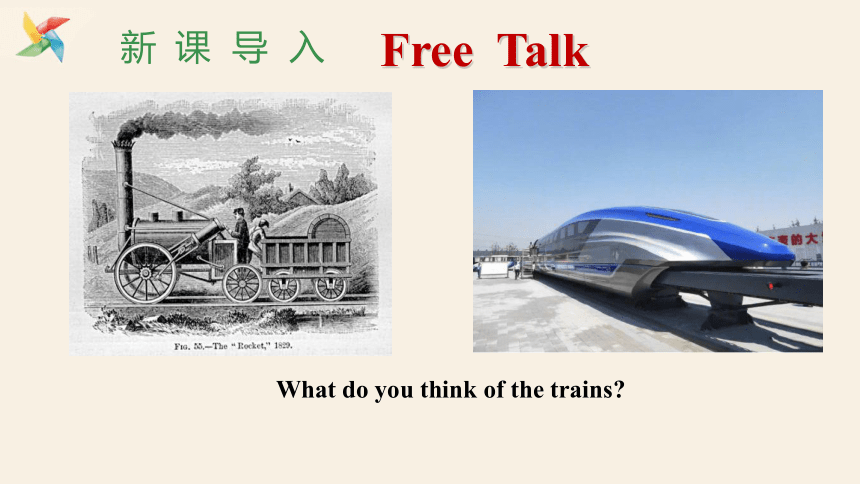
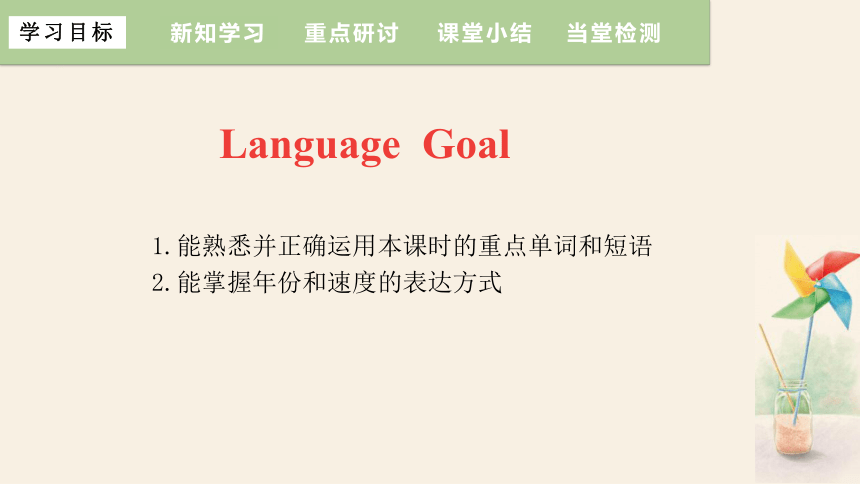
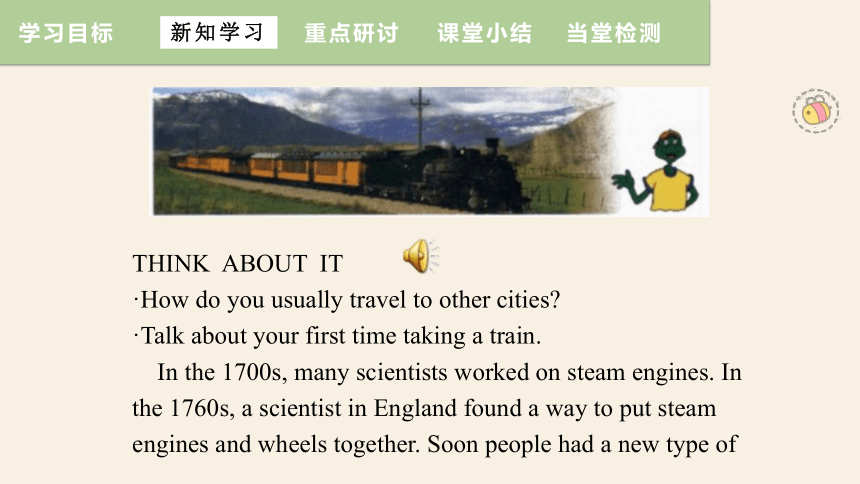

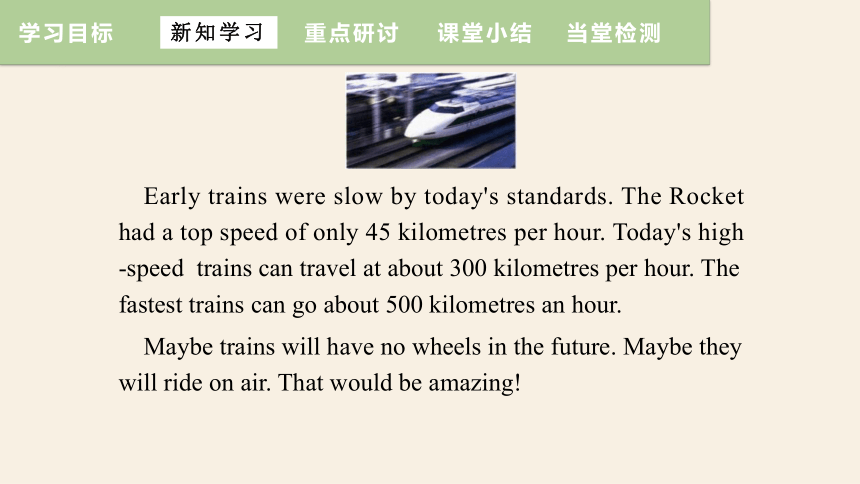
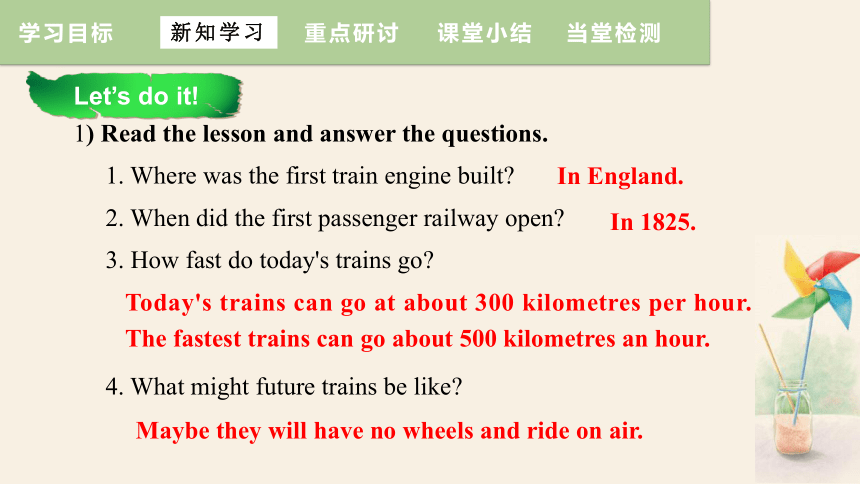
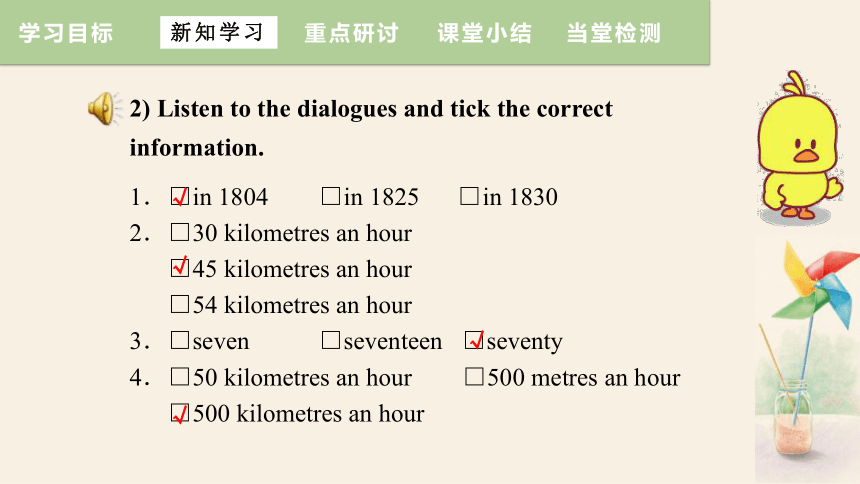
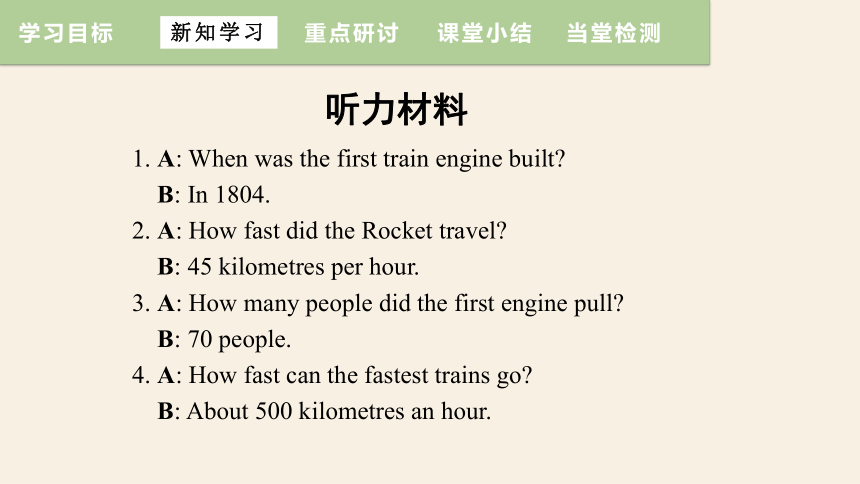
文档简介
(共21张PPT)
Unit 6
Go with Transportation!
Lesson 32
Trains Go Faster!
新
课
导
入
Free Talk
What do you think of the trains
Language Goal
新知学习
课堂小结
当堂检测
学习目标
重点研讨
1.能熟悉并正确运用本课时的重点单词和短语
2.能掌握年份和速度的表达方式
新知学习
课堂小结
当堂检测
学习目标
重点研讨
THINK ABOUT IT
·How do you usually travel to other cities
·Talk about your first time taking a train.
In the 1700s, many scientists worked on steam engines. In the 1760s, a scientist in England found a way to put steam engines and wheels together. Soon people had a new type of
新知学习
课堂小结
当堂检测
学习目标
重点研讨
transportation:the steam train.
In 1804, the first train engine was born in England.
It travelled only about fifteen kilometres in two hours. In 1825, the first passenger railway opened. The Rocket was the most famous early engine.
During the 1830s, countries all over the world started to build railways. Fifty years later many countries had railways. People built many train stations to help passengers get on and off the trains easily.
新知学习
课堂小结
当堂检测
学习目标
重点研讨
Early trains were slow by today's standards. The Rocket had a top speed of only 45 kilometres per hour. Today's high speed trains can travel at about 300 kilometres per hour. The fastest trains can go about 500 kilometres an hour.
Maybe trains will have no wheels in the future. Maybe they will ride on air. That would be amazing!
新知学习
课堂小结
当堂检测
学习目标
重点研讨
Let’s do it!
1) Read the lesson and answer the questions.
1. Where was the first train engine built
2. When did the first passenger railway open
3. How fast do today's trains go
4. What might future trains be like
Maybe they will have no wheels and ride on air.
In England.
In 1825.
Today's trains can go at about 300 kilometres per hour. The fastest trains can go about 500 kilometres an hour.
新知学习
课堂小结
当堂检测
学习目标
重点研讨
2) Listen to the dialogues and tick the correct information.
1.□in 1804 □in 1825 □in 1830
2.□30 kilometres an hour
□45 kilometres an hour
□54 kilometres an hour
3.□seven □seventeen □seventy
4.□50 kilometres an hour □500 metres an hour
□500 kilometres an hour
√
√
√
√
新知学习
课堂小结
当堂检测
学习目标
重点研讨
1. A: When was the first train engine built
B: In 1804.
2. A: How fast did the Rocket travel
B: 45 kilometres per hour.
3. A: How many people did the first engine pull
B: 70 people.
4. A: How fast can the fastest trains go
B: About 500 kilometres an hour.
听力材料
新知学习
课堂小结
当堂检测
学习目标
重点研讨
3) Complete the dialogue with the correct forms of the words in the box.
Tom: Hello John. How are you doing
John: Hi Tom. I'm doing well. Have you been to our new ________ ________?
Tom: Not yet. How about you
John: I went there last month. It's bright and beautiful.
railway station speed passenger
railway station
新知学习
课堂小结
当堂检测
学习目标
重点研讨
It's easy for ___________ to get on and off the train. It was exciting. The train went really fast. It can reach a top ________ of 500 kilometres an hour.
Tom: That's really fast! I hope to ride it soon.
passengers
speed
railway station speed passenger
重点研讨
课堂小结
当堂检测
学习目标
新知学习
4) Read the passage and answer the questions.
Over two thousand years ago,Chinese people invented kites. Kites can fly like birds,but they can't take people up into the sky. Hundreds of years later,the Wright brothers made the first successful experiment. A machine carrying a man rose into the sky using its own energy. It was the first plane. Inventors went on to improve planes. Two engineers,Frank Whittle of the U.K. and Hans Von Ohain of Germany,developed the jet plane during the late 1930s.
重点研讨
课堂小结
当堂检测
学习目标
新知学习
1. Who invented kites
2. Can kites take people up into the sky
3. Where was Frank Whittle from?
Chinese people.
No, they can't.
The U.K.
重点研讨
课堂小结
当堂检测
学习目标
新知学习
the 1760s 18世纪60年代
1
也就是1760~1769年,读作the seventeen sixties,
也可以写作the 1760's。
在其前须用定冠词the,在年代的后面加 s或加 's。
eg:Great changes took place in our country in the 1980s.
20世纪80年代我国发生了巨大变化。
重点研讨
课堂小结
当堂检测
学习目标
新知学习
2
born /b n/ v.出生
born常与be动词搭配,构成be born短语,表示“出生”。用于一般过去时,后跟介词in/on表示出生的时间或地点。注意:in后跟地点和年月,on后跟具体某一天。
eg:He was born in 1998.
他出生于1998年。
My son was born on April 18th.
我的儿子出生于4月18日。
重点研讨
课堂小结
当堂检测
学习目标
新知学习
during /'dj r / prep.在……期间
3
eg:Mary made a lot of friends during her vacation.玛丽在度假期间交了许多朋友。
作介词,不要将其误用作连词。
eg:He came to see me during my illness.(正确)
He came to see me during I was ill.(错误)
新知学习
课堂小结
当堂检测
学习目标
重点研讨
during通常表示事件发生在何时(when),而for则表示事件持续了多长时间(how long)。
eg:Bob was in hospital for six weeks during the
summer.
鲍勃在夏天的时候住了6个星期的医院。
during和for后均可接一段时间,但两者有差别。
重点研讨
课堂小结
当堂检测
学习目标
新知学习
4
speed /spi d/ n.速度
speed既可作可数名词,也可作不可数名词,常用短语:at a speed of,of后接数字表示具体的速度;at high/low/full speed 以高速/低速/全速。
eg:—What's the speed of your car now
你的车现在的速度是多少?
—At a speed of 80 kilometres per hour.
每小时八十公里。
课堂小结
重点研讨
当堂检测
学习目标
新知学习
重点单词:born,during, speed, per 等。
重点短语:in the 1760s, get on and off等
Unit 6
Lesson 32
当堂检测
重点研讨
课堂小结
学习目标
新知学习
用方框中所给单词的正确形式填空
1.Luckily, the baby was______ safely in the earthquake.
2.It is very strange that a car has only three ________.
3.A new ________station will be built in my hometown next year.
4.One of the________ famous sports stars will give us a speech
this Wednesday.
5.Our maths teacher asked us to write down the __________
answer on our test papers.
wheel, railway, much, bear, standard
born
railway
most
standard
wheels
当堂检测
重点研讨
课堂小结
学习目标
新知学习
连词成句
1.put,these,you,together,can,parts
_______________________________________?
2.wheels,it,how,have,does,many
________________________________________?
3.to,maybe,time,he,no,help,has
________________________________________.
4.plan,they're,a,working,new,on
________________________________________.
5. most, he's, writers, of, famous, one, the
_________________________________________.
Can you put these parts together
Maybe he has no time to help
They're working on a new plan.
He's one of the most famous writers.
How many wheels does it have
Unit 6
Go with Transportation!
Lesson 32
Trains Go Faster!
新
课
导
入
Free Talk
What do you think of the trains
Language Goal
新知学习
课堂小结
当堂检测
学习目标
重点研讨
1.能熟悉并正确运用本课时的重点单词和短语
2.能掌握年份和速度的表达方式
新知学习
课堂小结
当堂检测
学习目标
重点研讨
THINK ABOUT IT
·How do you usually travel to other cities
·Talk about your first time taking a train.
In the 1700s, many scientists worked on steam engines. In the 1760s, a scientist in England found a way to put steam engines and wheels together. Soon people had a new type of
新知学习
课堂小结
当堂检测
学习目标
重点研讨
transportation:the steam train.
In 1804, the first train engine was born in England.
It travelled only about fifteen kilometres in two hours. In 1825, the first passenger railway opened. The Rocket was the most famous early engine.
During the 1830s, countries all over the world started to build railways. Fifty years later many countries had railways. People built many train stations to help passengers get on and off the trains easily.
新知学习
课堂小结
当堂检测
学习目标
重点研讨
Early trains were slow by today's standards. The Rocket had a top speed of only 45 kilometres per hour. Today's high speed trains can travel at about 300 kilometres per hour. The fastest trains can go about 500 kilometres an hour.
Maybe trains will have no wheels in the future. Maybe they will ride on air. That would be amazing!
新知学习
课堂小结
当堂检测
学习目标
重点研讨
Let’s do it!
1) Read the lesson and answer the questions.
1. Where was the first train engine built
2. When did the first passenger railway open
3. How fast do today's trains go
4. What might future trains be like
Maybe they will have no wheels and ride on air.
In England.
In 1825.
Today's trains can go at about 300 kilometres per hour. The fastest trains can go about 500 kilometres an hour.
新知学习
课堂小结
当堂检测
学习目标
重点研讨
2) Listen to the dialogues and tick the correct information.
1.□in 1804 □in 1825 □in 1830
2.□30 kilometres an hour
□45 kilometres an hour
□54 kilometres an hour
3.□seven □seventeen □seventy
4.□50 kilometres an hour □500 metres an hour
□500 kilometres an hour
√
√
√
√
新知学习
课堂小结
当堂检测
学习目标
重点研讨
1. A: When was the first train engine built
B: In 1804.
2. A: How fast did the Rocket travel
B: 45 kilometres per hour.
3. A: How many people did the first engine pull
B: 70 people.
4. A: How fast can the fastest trains go
B: About 500 kilometres an hour.
听力材料
新知学习
课堂小结
当堂检测
学习目标
重点研讨
3) Complete the dialogue with the correct forms of the words in the box.
Tom: Hello John. How are you doing
John: Hi Tom. I'm doing well. Have you been to our new ________ ________?
Tom: Not yet. How about you
John: I went there last month. It's bright and beautiful.
railway station speed passenger
railway station
新知学习
课堂小结
当堂检测
学习目标
重点研讨
It's easy for ___________ to get on and off the train. It was exciting. The train went really fast. It can reach a top ________ of 500 kilometres an hour.
Tom: That's really fast! I hope to ride it soon.
passengers
speed
railway station speed passenger
重点研讨
课堂小结
当堂检测
学习目标
新知学习
4) Read the passage and answer the questions.
Over two thousand years ago,Chinese people invented kites. Kites can fly like birds,but they can't take people up into the sky. Hundreds of years later,the Wright brothers made the first successful experiment. A machine carrying a man rose into the sky using its own energy. It was the first plane. Inventors went on to improve planes. Two engineers,Frank Whittle of the U.K. and Hans Von Ohain of Germany,developed the jet plane during the late 1930s.
重点研讨
课堂小结
当堂检测
学习目标
新知学习
1. Who invented kites
2. Can kites take people up into the sky
3. Where was Frank Whittle from?
Chinese people.
No, they can't.
The U.K.
重点研讨
课堂小结
当堂检测
学习目标
新知学习
the 1760s 18世纪60年代
1
也就是1760~1769年,读作the seventeen sixties,
也可以写作the 1760's。
在其前须用定冠词the,在年代的后面加 s或加 's。
eg:Great changes took place in our country in the 1980s.
20世纪80年代我国发生了巨大变化。
重点研讨
课堂小结
当堂检测
学习目标
新知学习
2
born /b n/ v.出生
born常与be动词搭配,构成be born短语,表示“出生”。用于一般过去时,后跟介词in/on表示出生的时间或地点。注意:in后跟地点和年月,on后跟具体某一天。
eg:He was born in 1998.
他出生于1998年。
My son was born on April 18th.
我的儿子出生于4月18日。
重点研讨
课堂小结
当堂检测
学习目标
新知学习
during /'dj r / prep.在……期间
3
eg:Mary made a lot of friends during her vacation.玛丽在度假期间交了许多朋友。
作介词,不要将其误用作连词。
eg:He came to see me during my illness.(正确)
He came to see me during I was ill.(错误)
新知学习
课堂小结
当堂检测
学习目标
重点研讨
during通常表示事件发生在何时(when),而for则表示事件持续了多长时间(how long)。
eg:Bob was in hospital for six weeks during the
summer.
鲍勃在夏天的时候住了6个星期的医院。
during和for后均可接一段时间,但两者有差别。
重点研讨
课堂小结
当堂检测
学习目标
新知学习
4
speed /spi d/ n.速度
speed既可作可数名词,也可作不可数名词,常用短语:at a speed of,of后接数字表示具体的速度;at high/low/full speed 以高速/低速/全速。
eg:—What's the speed of your car now
你的车现在的速度是多少?
—At a speed of 80 kilometres per hour.
每小时八十公里。
课堂小结
重点研讨
当堂检测
学习目标
新知学习
重点单词:born,during, speed, per 等。
重点短语:in the 1760s, get on and off等
Unit 6
Lesson 32
当堂检测
重点研讨
课堂小结
学习目标
新知学习
用方框中所给单词的正确形式填空
1.Luckily, the baby was______ safely in the earthquake.
2.It is very strange that a car has only three ________.
3.A new ________station will be built in my hometown next year.
4.One of the________ famous sports stars will give us a speech
this Wednesday.
5.Our maths teacher asked us to write down the __________
answer on our test papers.
wheel, railway, much, bear, standard
born
railway
most
standard
wheels
当堂检测
重点研讨
课堂小结
学习目标
新知学习
连词成句
1.put,these,you,together,can,parts
_______________________________________?
2.wheels,it,how,have,does,many
________________________________________?
3.to,maybe,time,he,no,help,has
________________________________________.
4.plan,they're,a,working,new,on
________________________________________.
5. most, he's, writers, of, famous, one, the
_________________________________________.
Can you put these parts together
Maybe he has no time to help
They're working on a new plan.
He's one of the most famous writers.
How many wheels does it have
同课章节目录
- Unit 1 Me and My Class
- Lesson 1 Back to School!
- Lesson 2 Many Faces, One Picture
- Lesson 3 Getting to Know You!
- Lesson 4 Best Friends
- Lesson 5 Meet Ms. Liu
- Lesson 6 Jenny's Week
- Unit 2 My Favourite School Subject
- Lesson 7 Don't Be Late for Class!
- Lesson 8 E-mail Helpers!
- Lesson 9 I Don't Want to Miss Geography !
- Lesson 10 Looking for Lisa
- Lesson 11 Lily Learns about China !
- Lesson 12 Karen's Hair Stood Up!
- Unit Review
- Unit 3 Families Celebrate Togethe
- Lesson 13 I Love Autumn
- Lesson 14 Happy Memories
- Lesson 15 A Present for Li Ming!
- Lesson 16 Happy Thanksgiving!
- Lesson 17 Presents from Canada!
- Lesson 18 Li Ming's Birthday
- Unit Review
- Unit 4 My Neighbourhood
- Lesson 19 The Best Neighourhood
- Lesson 20 No Stopping!
- Lesson 21 Eat a Donut and Turn Right
- Lesson 22 I Like My Neighbourhood
- Lesson 23 People in My Neighbourhood
- Lesson 24 I Need a Map!
- Unit Review
- Unit 5 My Future
- Lesson 25 I Want to Be a Teacher!
- Lesson 26 What Will I Be ?
- Lesson 27 What's Your Advice?
- Lesson 28 Rich or Poor? It Doesn't Matter!
- Lesson 29 Our Ambitions and Dreams
- Lesson 30 A Famous Friend?
- Unit Review
- Unit 6 Go With Transportation !
- Lesson 31 How Do You Travel ?
- Lesson 32 Trains Go Faster !
- Lesson 33 Life on Wheels
- Lesson 34 Flying Donuts
- Lesson 35 Future Transportation
- Lesson 36 Clean Cars ?
- Unit Review
- Unit 7 Enjoy Your Hobby
- Lesson 37 What's Your Hobby ?
- Lesson 38 Hobbies Are Fun!
- Lesson 39 Danny's Hobby
- Lesson 40 What's Paul's Hobby?
- Lesson 41 Show and Tell!
- Lesson 42 The New Club
- Unit Review
- Unit 8 Celebrating Me
- Lesson 43 What Makes You Unique?
- Lesson 44 Georgia Plays Basketball
- Lesson 45 Be Yourself !
- Lesson 46 My Dream
- Lesson 47 I Made It !
- Lesson 48 Li Ming's Report
- Unit Review
